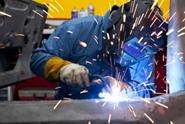Economy

Global Manufacturing Improves in 22 of 30 Nations
Written by Sandy Williams
December 4, 2016
Manufacturing conditions improved across the globe in November, according to the latest JP Morgan Global Manufacturing PMI. The composite index rose to a 27 month high of 52.1, inching up slightly from 52.0 in October.
Expansion was noted in 22 of the 30 nations covered under the global survey. New order growth was the strongest seen since 2014. Export traffic rose for the fifth month and to the highest amount in two years. Developed markets like the U.S., Eurozone, Japan and U.K. saw the most gains while emerging markets declined slightly due to reduced flow of exports to China, South Korea, Russia and Brazil.
 Demand appeared to exceed supply in parts of the manufacturing sector and in the supply chain. Backlogs increased for the sixth month as average vendor lead times lengthened.
Demand appeared to exceed supply in parts of the manufacturing sector and in the supply chain. Backlogs increased for the sixth month as average vendor lead times lengthened.
Input costs were elevated over much the global manufacturing economy, especially in China, the UK, Italy, Taiwan, the Netherlands, Mexico, Vietnam, and Turkey. Output charges rose at the fastest pace in almost five-and-a-half years led by gains in emerging markets.
Eurozone
Manufacturing conditions continue to improve in the Eurozone. The PMI rose to 53.7 from 53.5 in October. A weaker euro is stimulating greater domestic demand and higher export levels. Employment levels rose in in all eight nations in the region. Prices for raw materials increased in November causing manufacturers to pass along part of the increased cost to clients.
China
The Caixin China General Manufacturing PMI slipped slightly in November to 50.9 from October’s reading of 51.2 but was still the second highest reading in two years. Production and new orders declined but input and output prices rose to a five year high as inflationary pressure intensified.
Dr. Zhengsheng Zhong, Director of Macroeconomic Analysis at CEBM Group commented: “The Chinese economy continued to improve in November, although it lost some momentum compared to the previous month. Inventory and employment data also showed the foundation of growth is not solid yet and investors have to remain vigilant about the risk of a downturn in coming months.”
Russia
Russia’s manufacturing sector had its best performance since early 2011. The headline PMI rose to 53.6 from 52.5 for 68-month high. Stronger domestic demand led to higher output and new orders during the month. Export orders, however, continued to decline, but at a softer pace. Markit says Russian manufacturers are on course to enjoy their strongest quarter in almost six years.
Brazil
Brazil continues to suffer from a severe recession. Production, new orders, and employment dropped for another month. The headline PMI was at 46.2, almost unchanged from October’s reading.
IHS economist Pollyanna De Lima commented, “The contraction in Brazilian manufacturing output now stretches to almost two years, and there was little, if any, from the November’s PMI survey to suggest an imminent upturn is in sight. Incoming new work decreased at a faster pace, with falling exports contributing to the overall downturn in new business intakes.”
Mexico
Manufacturing growth slowed in Mexico during November with increases in production, new orders and new export orders increasing at a softer pace. Markit attributes the weaker November to headwinds from subdued export sales. The headline PMI slipped to 51.1 from 51.8 the previous month.
Canada
Overall business conditions in Canada improved to their strongest level since July. The Markit Canada PMI rose to 51.5 in November from 51.1 in October. Production picked up after a flat October and export orders rose for the first time since June. Markit says anecdotal reports point to a rebound in energy sector spending, supporting new orders and export sales.
United States
Markit’s US Manufacturing PMI grew to 54.1 from 53.4 in October and was the strongest improvement in business conditions for the year. New business volume was driven by domestic sales and backlogs rose for the sixth consecutive month. Higher production was also attributed to inventory building.
Commenting on the final PMI data, Chris Williamson, Chief Business Economist at IHS Markit said: “Both production and order books are growing at impressive rates, fueled predominantly by rising domestic demand for goods from both consumers and businesses. Companies are also rebuilding stock levels, suggesting the recent inventory drag is easing.
“The stronger dollar is hurting exporters, but the flip-side of the exchange rate appreciation is lower import costs, which have in turn helped to ameliorate the impact of rising global commodity prices compared to other countries.
“However, although employment rose, the survey found ongoing caution in respect to hiring new staff, linked in turn to uncertainty about the outlook and worries about rising costs.”

Sandy Williams
Read more from Sandy WilliamsLatest in Economy

Architecture billings continue to slide in March
Architecture firms said billings continued to decline in March, according to the latest Architecture Billings Index (ABI) released by the American Institute of Architects (AIA) and Deltek.

Beige Book shows concerns about trade policy
Manufacturing was mixed, but two-thirds of districts said activity was little changed or had declined.

New York state manufacturing index drops again in April
Firms were pessimistic, with the future general business conditions index falling to its second lowest reading in the more than 20-year history of the survey

Construction adds 13,000 jobs in March
The construction sector added 13,000 jobs, seasonally adjusted, in March, but tariffs could undermine the industry.

Supply chains, end-users brace for impact from tariffs
Supply chains are working through what the tariffs mean for them
